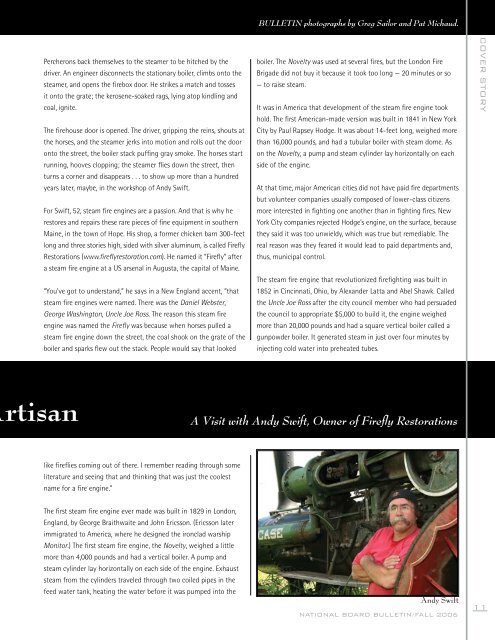bulletin - The National Board of Boiler and Pressure Vessel Inspectors
bulletin - The National Board of Boiler and Pressure Vessel Inspectors
bulletin - The National Board of Boiler and Pressure Vessel Inspectors
Create successful ePaper yourself
Turn your PDF publications into a flip-book with our unique Google optimized e-Paper software.
tisan<br />
Percherons back themselves to the steamer to be hitched by the<br />
driver. An engineer disconnects the stationary boiler, climbs onto the<br />
steamer, <strong>and</strong> opens the firebox door. He strikes a match <strong>and</strong> tosses<br />
it onto the grate; the kerosene-soaked rags, lying atop kindling <strong>and</strong><br />
coal, ignite.<br />
<strong>The</strong> firehouse door is opened. <strong>The</strong> driver, gripping the reins, shouts at<br />
the horses, <strong>and</strong> the steamer jerks into motion <strong>and</strong> rolls out the door<br />
onto the street, the boiler stack puffing gray smoke. <strong>The</strong> horses start<br />
running, hooves clopping; the steamer flies down the street, then<br />
turns a corner <strong>and</strong> disappears . . . to show up more than a hundred<br />
years later, maybe, in the workshop <strong>of</strong> Andy Swift.<br />
For Swift, 52, steam fire engines are a passion. And that is why he<br />
restores <strong>and</strong> repairs these rare pieces <strong>of</strong> fine equipment in southern<br />
Maine, in the town <strong>of</strong> Hope. His shop, a former chicken barn 300-feet<br />
long <strong>and</strong> three stories high, sided with silver aluminum, is called Firefly<br />
Restorations (www.fireflyrestoration.com). He named it “Firefly” after<br />
a steam fire engine at a US arsenal in Augusta, the capital <strong>of</strong> Maine.<br />
“You’ve got to underst<strong>and</strong>,” he says in a New Engl<strong>and</strong> accent, “that<br />
steam fire engines were named. <strong>The</strong>re was the Daniel Webster,<br />
George Washington, Uncle Joe Ross. <strong>The</strong> reason this steam fire<br />
engine was named the Firefly was because when horses pulled a<br />
steam fire engine down the street, the coal shook on the grate <strong>of</strong> the<br />
boiler <strong>and</strong> sparks flew out the stack. People would say that looked<br />
like fireflies coming out <strong>of</strong> there. I remember reading through some<br />
literature <strong>and</strong> seeing that <strong>and</strong> thinking that was just the coolest<br />
name for a fire engine.”<br />
<strong>The</strong> first steam fire engine ever made was built in 1829 in London,<br />
Engl<strong>and</strong>, by George Braithwaite <strong>and</strong> John Ericsson. (Ericsson later<br />
immigrated to America, where he designed the ironclad warship<br />
Monitor.) <strong>The</strong> first steam fire engine, the Novelty, weighed a little<br />
more than 4,000 pounds <strong>and</strong> had a vertical boiler. A pump <strong>and</strong><br />
steam cylinder lay horizontally on each side <strong>of</strong> the engine. Exhaust<br />
steam from the cylinders traveled through two coiled pipes in the<br />
feed water tank, heating the water before it was pumped into the<br />
BULLETIN photographs by Greg Sailor <strong>and</strong> Pat Michaud.<br />
boiler. <strong>The</strong> Novelty was used at several fires, but the London Fire<br />
Brigade did not buy it because it took too long — 20 minutes or so<br />
— to raise steam.<br />
It was in America that development <strong>of</strong> the steam fire engine took<br />
hold. <strong>The</strong> first American-made version was built in 1841 in New York<br />
City by Paul Rapsey Hodge. It was about 14-feet long, weighed more<br />
than 16,000 pounds, <strong>and</strong> had a tubular boiler with steam dome. As<br />
on the Novelty, a pump <strong>and</strong> steam cylinder lay horizontally on each<br />
side <strong>of</strong> the engine.<br />
At that time, major American cities did not have paid fire departments<br />
but volunteer companies usually composed <strong>of</strong> lower-class citizens<br />
more interested in fighting one another than in fighting fires. New<br />
York City companies rejected Hodge’s engine, on the surface, because<br />
they said it was too unwieldy, which was true but remediable. <strong>The</strong><br />
real reason was they feared it would lead to paid departments <strong>and</strong>,<br />
thus, municipal control.<br />
<strong>The</strong> steam fire engine that revolutionized firefighting was built in<br />
1852 in Cincinnati, Ohio, by Alex<strong>and</strong>er Latta <strong>and</strong> Abel Shawk. Called<br />
the Uncle Joe Ross after the city council member who had persuaded<br />
the council to appropriate $5,000 to build it, the engine weighed<br />
more than 20,000 pounds <strong>and</strong> had a square vertical boiler called a<br />
gunpowder boiler. It generated steam in just over four minutes by<br />
injecting cold water into preheated tubes.<br />
A Visit with Andy Swift, Owner <strong>of</strong> Firefly Restorations<br />
Andy Swift<br />
NATIONAl BOARD BUllETIN/FAll 2006<br />
COVER STORY<br />
11








